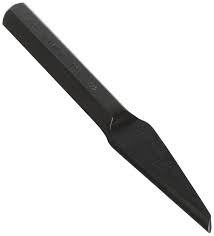Cold Chisels are used for cutting and chipping away pieces of metal and are made of carbon steel usually rectangular , hexagonal or octagonal cross-section. They are forged to shape, roughly ground, and then hardened and tempered. Afterwards the edge is ground sharp to the correct cutting angle, care being taken not to overheat the steel and draw the temper. The cutting angle given to the chisel is determined mainly by the nature of the metal to be chipped. It varies between 35* to 70* , the less acute angles being for the harder and tougher metals.
The Chisel is subdivided into cutting edge, shank and head, and this is generally specified by the length. and width of the cut ting edge ; and particularly by the width of the cutting edge. A 25 mm cold chisel means a chisel with a 25 mm wide cutting edge. The shape of its cutting edge is also required to completely specify the chisel. The five most common types are the flat, the cross-cut, the diamond pointed, the half round and the side chisel. Apart from the cutting angle, other angles that can be specified for a chisel are : 1. rake angle 2. Forging angle. 3. clearance angle.
The rake angle is the angle which is made by the upper taper surface of the chisel point and a line perpendicular to the point of the metal surface which the tip touches. The clearance angle is dependent of the way the operator drives it and this angle is kept more than 10* for proper digging the metal. Forging angle is kept around 25* to 30*.
Flat Chisel :
The flat chisel is the most common of all the chisels used in the engineering. It is the chisel which is used for most of the general chipping operations. It may be used for removing surplus metal from surfaces of jobs.
The flat chisel should be drawn down to the shape shown in the diagram. The cutting edge should be slightly curved as shown as this will prevent the corners digging in when it is being used.
The length of the flat chisel varies from 100 to 400 mm, while the width of the cutting edge varies from 16 to 32 mm.
Cross-cut Chisel : The cross cut chisel or cape chisel as it is sometimes called, is used for cutting grooves in large surfaces previous to using the flat chisel, and is also used in cutting key ways in the wheels and shafts.
The cutting edge is slightly wider than the supporting metal to provide clearance. Length of this chisel varies from 100 to 400 mm, and width of the edge varies from about 4 to 12 mm.
Half round Chisel : A half round chisel is particularly useful for the cutting oil-ways or grooves in bearing, bosses and pulleys etc. They are also used for setting-over pilot holes. When a hole is to drilled a smaller or pilot hole is drilled first.
The shank is reduced to a half-round taper , which is the beveled at the end to give a circular edge. length varies from 150 to 250 mm and width of the cutting edge from 2 to 16 min.
Diamond Point Chisel : The diamond point chisel is used for cutting vee grooves, cleaning grooves, cleaning corners and squaring small holes.
The Chisel is drawn to a square section. The end is ground off at an angle producing the "diamond" shape. Length of this chisel varies from 100 to 400 mm and width of the cutting edge from 6 to 16mm.
Side Chisel : A side chisel is particularly useful in chipping and removing the surplus metal in the cotter ways and slots, which may have to be cut by hand after after having been drilled.
The shank of the chisel is bent out a little side way, and then vertically down again.






Comments
Post a Comment